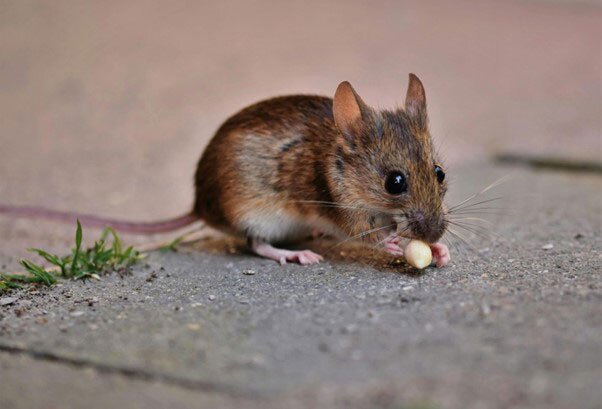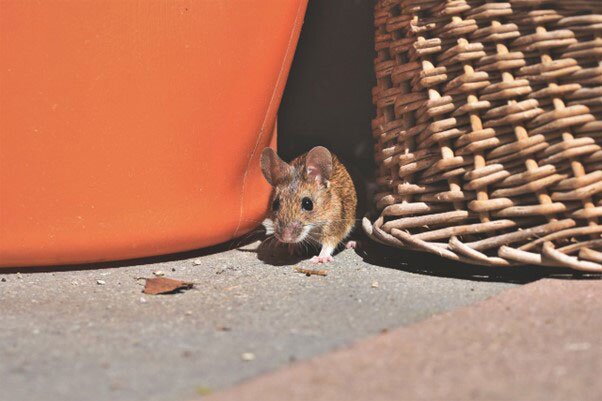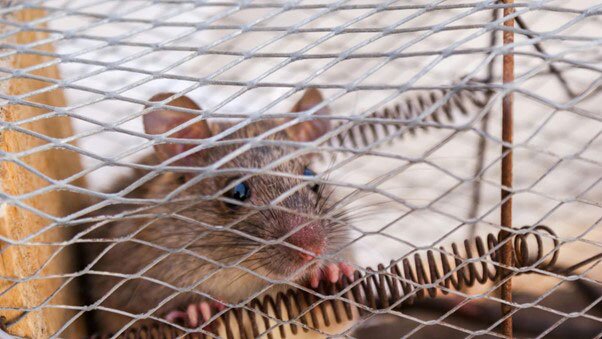Whether you love them or loathe them, no one wants mice as uninvited guests in the home. While you may find them cute, they are also carriers of many diseases, plus they can cause property damage by chewing through insulation, wires, and even pipes. On top of all this, getting rid of mice can be difficult, especially if you have a full infestation.

Fortunately, there are several steps you can take to mouse-proof your home and prevent these pesky pests from making their way into your house. In this guide, we’ll cover how to deter mice with mouse mesh and other natural methods, as well as how to get rid of mice for those already living with them.
What you need to know about mice in your home
If you want to keep mice out of your home, or they are already there and you want to get rid of them, it can help to understand more about them. Here, we’ll cover everything you need to know about mice in the home, from what attracts them to their lifespan and breeding habits.

What attracts mice?
If you’re wondering “why do I have mice in my house?”, it may be because you are unintentionally attracting them to your home. One of the main things attracting mice to a space is food, whether in the form of crumbs, open packets of food, or open rubbish bins. They can also be attracted by pet food, including not just cat and dog food but rabbit food, fish food, bird food, and of course, food for pet rodents. Water sources can tempt mice in too, such as leaking pipes, condensation, and pet water bowls.
Another thing which can attract mice to your home is warmth and shelter. Mice tend to seek shelter from the cold, particularly in the winter months, which makes homes a prime target. They often use warm and sheltered spaces as places to nest and breed, which is what leads to full infestations.
Beyond food, warmth, and shelter, cluttered areas such as garages, pantries, and storage rooms can give mice safe places to hide and nest. In the garden, they can also be attracted to nest in trees, bushes, and other shrubbery.
How do mice get in the house?
You may be wondering how mice get into your house as there are no obvious entry points. But they can squeeze into surprisingly small gaps, making it easy for them to enter many homes. Gaps under doors, skirting boards, holes in walls, and unsealed pipes are some of the most common entry points. Poorly fitted windows and gaps in attic vents are also popular entryways for these crafty intruders.
Where do mice live?
As we already know, mice like to make themselves at home in our houses. They tend to look for cosy, hidden spots that are undisturbed to make their nests, such as inside walls, lofts, garages, and basements. They also choose spots near food and water sources, so they commonly make nests under kitchen cabinets and pantries. Outside, they make homes in thick vegetation, under garden sheds, or in compost piles, as well as in disused buildings.
When do mice come out?
As nocturnal creatures, mice tend to come out half an hour after sunset and half an hour before sunrise. If you have a mouse in the home, you may hear them scratching and scrabbling around at night, once the house is dark and quiet. There is a chance that you’ll hear or spot them during the day if they are out searching for food or water.
How long do mice live?
The lifespan of a mouse depends largely on their environment. In the wild, mice tend to live up to 12 months, partly due to the conditions they live in and also because of predators (Orkin). A house mouse which has made a nest in your home and has access to food and water sources can live for around two years.
How quickly do mice breed?
While you may have heard the phrase “breeding like rabbits”, “breeding like mice” would be even more apt! Mice can start to breed as young as six weeks old and their typical gestation period is just between 19 and 21 days (Terminix). Litters usually contain anything from five to 12 pups, and the same female mouse can produce a staggering ten litters per year. With these figures, it’s easy to see how a single mouse intruder can spiral into a whole infestation so quickly.
How many mice are in a nest?
The size of a mouse nest can vary, but it usually houses at least five mice (Fantastic Pest Control). As mice breed rapidly, a small nest can quickly grow into a much larger group, leading to extensive infestations. Multiple nests may also form around the house as the population expands, making it crucial to act quickly if you suspect mice are present.
How high can mice jump?
Mice are surprisingly agile. They can jump up to 33cm (13 inches) in height from the ground up to another flat surface, and a whopping 60cm (24 inches) horizontally, making it easy for them to access countertops and shelves (Stampede Pest Control). Their agility also helps them evade capture. They are very good climbers, and combined with their speed, which can reach up to 8mph, they are very difficult to corner without catching them by surprise.
What are some common signs of mice in the home?
It can be difficult to spot signs of mice in the home until it becomes a full infestation, so it’s important to be vigilant, especially if you have dealt with infestations in the past. Some of the most common signs of mice in the home include:
- Mouse droppings
- Scratching or scurrying sounds, especially at night
- A strong distinctive scent, which is a combination of ammonia and urine
- Unexplained grease marks on walls and/or skirting boards
- New or widened holes around doors, windows, and walls
- Pets sniffing around one spot repeatedly, especially if it is near a small gap or hole
What do mice droppings look like?
Mouse droppings are small (around a quarter of an inch long), dark brown or black, and pointed at both ends, resembling dark grains of rice. Fresh droppings are soft and dark, while older ones harden and lighten in colour. A mouse can produce around 50 to 75 pellets per day, so if you have an infestation you will likely find a significant number of droppings (Terminix). It’s worth noting that mouse droppings don’t have a distinctive or noticeable smell, unlike their urine which has a strong ammonia-like scent.
Why do mice suddenly disappear?
Some people find that their uninvited guests vanish suddenly. This is surprisingly common and can happen for a number of reasons, however, it is usually only a temporary exit. One of the reasons is that mice are very shy creatures, so if they detect human activity or loud noises, they may temporarily retreat. Changes in the environment, such as reduced food sources or blocked entry points, can also cause mice to leave. Alternatively, some mice may relocate their nest within the house or simply reduce their activity during the day to avoid being spotted.
How to deter mice
Now you know how resourceful mice can be, it may feel impossible to stop them from sneaking into your home and taking over. Fortunately, there are various practical ways to deter mice and make your house a less appealing option for these unwelcome guests. Read on to find out how to keep mice away and prevent infestations from taking over your home.

Seal potential entry points
Mice are notorious for slipping through tiny openings, managing to contort their bodies to squeeze through very small gaps. There is conflicting information online referring to mice being able to fit through gaps as small as 5mm, however, this refers to mice being able to contort their bodies — this gap would need to be wider in the other direction for a mouse to fit the rest of its body through. To prevent mice from contorting their way in, it’s important to check your home for these tiny crevices and use a wire mesh with a square hole no bigger than 6mm x 6mm to block potential entry points. Check the openings around external points of your home such as around doors, windows, vents, and pipes.
Here at Mesh Direct, we have a great selection of mouse-proof wire mesh. This includes 6mm by 6mm welded mesh and stainless steel mesh. Both of these mouse mesh options are manufactured with durable chew-proof steel, meaning that there is no way for those pesky pests to make their way into your home. We also sell 2mm by 2mm mouse vent protection covers that protect against bees and wasps in addition to mice.
Be careful with crumbs
As we already know, one of the main things which attracts mice to a home is a food source. Even the smallest crumbs can be enough to tempt them in and set up a nest, so it’s important to be diligent with food and crumbs. After preparing a meal and eating, make sure to clean the countertops and sweep the kitchen and dining area for any crumbs. On top of this, store your food in airtight containers when possible and avoid leaving pet food out overnight, as this is when mice are active. You should also avoid having overflowing bin bags and take the rubbish out often, particularly rubbish bags containing food waste. A clean and tidy home is far less attractive to mice, so staying on top of crumbs and spills is an essential step in deterring them.
Tidy the garden
Before a mouse starts living in your home, they are often living in your garden. They tend to use overgrown gardens as spots to nest in before finding a way inside for more warmth and shelter. By tidying up your garden and getting rid of these nesting spots, you can make your outdoor space less appealing to them, which in turn can deter them from your property. You can do this by trimming overgrown bushes and shrubbery, keeping your grass short, and removing any piles of leaves or firewood which mice can use for shelter. You should avoid placing compost bins or bird feeders close to the house as well, as these can attract mice as food sources.
You can use our mouse protection mesh in the garden to keep your outdoor space free from the pests. Use a staple tacker to fix the mesh to wooden fence posts or wooden sheds, or use wall screws and washers if attaching it to brick or concrete.
Use natural repellents
There are several gentle yet effective methods you can try to deter mice naturally. There are a variety of mouse repellent sprays on the market, but you can easily make your own repellent by simply using scents they don’t like to keep them away.
What smells do mice hate?
If you’re wondering what scent will keep mice away, you may be surprised to hear that one of the most effective is also a pleasant smell to humans – peppermint! Mice have a very strong sense of smell, and as peppermint is such a potent scent it can overwhelm and irritate their senses, so they try to avoid the scent as much as possible. You can use this to your advantage by soaking cotton wool balls in peppermint essential oil and leaving them near potential mouse entry points.
There are a few other scents that mice find unappealing too. For instance, vinegar, cinnamon, cloves, and eucalyptus oil are all strong-smelling substances that mice tend to avoid. Ammonia can also be an effective mouse deterrent, as the smell mimics the scent of predator urine.
While these natural methods can be effective, it’s worth doing them in combination with using protective mesh and keeping the house and garden clean and crumb-free to stand the highest chance of success.
How to get rid of mice
If you suspect you already have mice in your home, you must act quickly. It doesn’t take long for just one or two mice to become a whole infestation, which is much more difficult to remove. Here, we explain the main methods for getting rid of mice, from humane traps for getting rid of mice naturally to more decisive measures.

How to catch mice
If you’re looking for the most humane way to get rid of mice, catching them in a live trap and setting them free is the best option. Also known as catch-and-release traps, they are designed to capture the mouse alive so you can free them somewhere not close to your property (at least a mile away), ideally in a wooded area. There are a variety of different types available on the market, but every one needs bait inside to attract the mouse. For bait, opt for a high-calorie food rich in fat, such as peanut butter, hazelnut spread, nuts, bacon, or of course, cheese. Remember, these traps must be checked frequently, as mice can die if left inside for too long without food or water.
How to kill mice
While most of us prefer to use live traps wherever possible, unfortunately, this sometimes isn’t a practical solution, especially if you’re dealing with a suspected infestation. If you do choose traps which kill, always opt for humane ones which kill instantly and avoid glue traps at all costs, as these are very distressing for the animal. Classic snap traps ensure a quick death, as do electric mouse traps. If there is a significant infestation, you should contact a pest control service to do the job for you as they should have the tools to get rid of mice quickly and humanely.
Killing the mice is always a last resort and it isn’t a pleasant job. To minimise your risk of having to do this, deterring mice from entering your property in the first place should be your priority.
How to get rid of mice in walls
Catching mice in walls can be more of a challenge, as once they are in there they can be difficult to get out. The first step to getting rid of mice in walls is finding their entry and exit points. Check your home’s exterior and interior for any cracks or holes. However, don’t cover them up until you are certain you have caught all the mice.
Once you’ve identified all of the entry/exit points, place traps near all of these openings. They will need to exit the walls to look for food, and placing traps strategically can help catch them on their way out. Some people also use ultrasonic repellers, which emit sound waves that are supposedly uncomfortable for mice. While results vary, these can sometimes encourage mice to leave walls, especially if combined with other methods.
Unfortunately, mice in the walls can be a sign of a more significant infestation, so there is a chance you won’t be able to control the issue yourself. If you aren’t having any success getting rid of the mice on your own, you should consider calling a professional pest control service.
After reading this guide you should feel confident in knowing how to get rid of mice, and more importantly, how to keep mice away in the first place. Prevention is always better than cure, so use our mouse mesh to keep the animals at bay.
Looking for more pest protection essentials? Here at Mesh Direct, we have a huge range of wire mesh to explore, including rat mesh, mole mesh, and squirrel mesh, as well as dog fencing, cat fencing, and aviary mesh for protecting the animals you do want in your home. Shop the full collection today, and for more tips on keeping pests out, make sure to read our guide on getting rid of flies.




